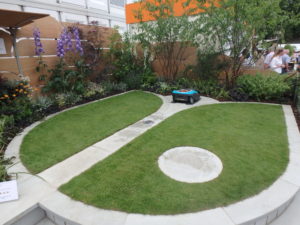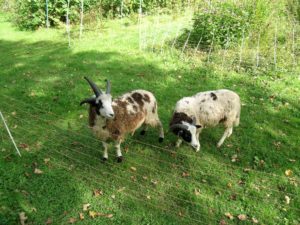Fall Lawn Care

This robot mower from the Chelsea Flower Show is quite a leap from the sheep that were the original mowers
I have to admit that I don’t pay much attention to my lawn. I mow it as needed, but don’t fuss about dandelions, which I consider cheerful. But I realize many gardeners DO care about their lawns, so I will share with you a few tips for the fall.
There are often places on lawns where someone left a wading pool or forgot a pile of weeds. Now is a good time to re-seed. Why? The soil is warmer than in the spring, and it is less likely to dry out now than in the summer.
To fill in a bare spot, first scuff the area with a garden rake – the kind with strong, short tines. Then spread some good compost, perhaps half an inch of it. Mix that in with your rake. Compost encourages healthy bacteria and fungi to live in the soil, supporting your lawn.
Next, spread seed over the area. For small areas, you can just take seed in your hand and fling it. Seed spreaders are sold if you have a large area. After seeding, drag a lawn rake over the area upside down – with the tips of the tines up. That will mix the seed with the soil and compost, but not rake the seed away the way it would if the tines were down. Pat down the area with a tamper, your feet, or a lawn roller if you can get your hands on one.
There are special fertilizers available for lawns, but I’m not a fan of chemical fertilizers for a number of reasons: they are made with chemicals that are not suitable for organic gardeners. Some are even combined with pesticides of various types – to prevent weeds, insects, grubs, fungus or moss. Even organic fertilizers need to be used with care: phosphorous (the middle number in the 5-10-5 designation) is prohibited in any lawn fertilizer in many states because phosphorous can cause problems in waterways.
Some people like to shade the newly planted area by spreading a thin layer of mulch hay or straw. That helps to keep the new seed from drying out in the sun. The grass will grow right through it. Be sure to water if the soil starts to dry out. It is critical to keep the seeds from drying our once planted.
Over-seeding is good to do now, too. That means adding some seed to thin places, not just those bare spots. Follow the same procedure: scuff, add compost, seed, mix in with your rake.
What seed should you use? I generally recommend a “conservation mix”. This has a mixture of varieties of tough grasses including tall fescue. I like Dutch white clover in the mix, as it will take nitrogen from the air and add it to the soil – free fertilizer. Clover, however, is killed by the herbicides sold to kill weeds in lawns. Kentucky bluegrass is sometime touted as the best grass for lawns, but it is a high-maintenance variety, and should never be more than 20% of a mix.
If you have trees shading your lawn, get lawn seed designated for shady areas. If not, it will not thrive. And over time, a sunny lawn often becomes a shady lawn as trees along the perimeter get bigger. Maples steal a lot of water and nutrients from a lawn, and their roots extend way past their drip line.
What should you do about moss in the lawn in shady spots? I like it. You can let it take over, or you can rake it out and add limestone to sweeten the soil – moss likes acidic soil. And I guess you have to cut down some trees or lop off branches to get more sun on those mossy places. Me? I live with it. I’ve seen labels on bags on “Death Row” (the chemical aisle at the garden center) that promise “No More Moss for a Year” and shudder at thoughts of my earthworms and beneficial fungi and bacteria dying from the moss killer. Ugh!
Fall is a good time to send off a soil sample to your state university extension service to see what the soil is like in your lawn. If the soil pH is less than six, you should add some limestone this fall. It will raise the number, but slowly, so it’s good to do it now. The report will tell you how much limestone to add, and should also tell you if you need to add organic matter, phosphorous, potassium or magnesium. If you are low on magnesium, buy dolomitic limestone, not calcitic limestone.
If you walk across the lawn in the same path every day, eventually the grass will get so compacted it will stop growing, particularly if you walk on it when the grass is wet. The solution? Put down stepping stones or pavers as lawn will not thrive in compacted soil.
If you plan to put down stones, cut out the grass underneath them first. Do this by using an old steak knife. Cut around a stone, then move it and dig out the sod and any soil needed so that the stone will be about level with the lawn. I like a CobraHead weeder for that. By having the stones level with the lawn you can mow over it without hitting them with the mower.
Fall leaves are great for the grass. Put the mulcher attachment on your mower to chop them up fine, starting now, and let the earthworms feast on them. Don’t leave too thick a layer, however, as it can choke the grass.
A little lawn is a nice thing. But my philosophy is this: if it’s green and you can mow it, it’s a lawn. I’ll never get hung up on having a magazine-perfect lawn.
Henry hopes to help lead a Viking Cruise from Paris to Normandy next June, including a stop at Monet’s garden in Giverny. For more info, e-mail Henry at henry.homeyer@comcast.net. He will be giving gardening lectures evenings on the boat.



